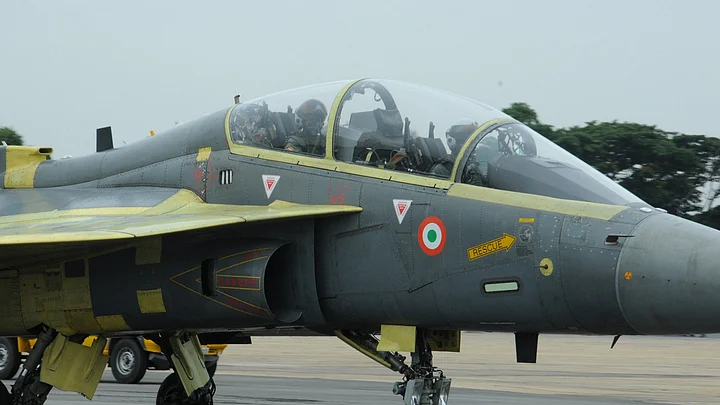In the midst of a cool south-western monsoon breeze, the Hindustan Aeronautics Limited (HAL) airport at Bengaluru wore a festive look for what is without doubt an aeronautically-historic occasion. On behalf of the Indian Air Force (IAF), its Deputy Chief, Air Marshal Jasbir Walia, is all set to receive the first two series production Tejas light combat aircraft (LCA) from HAL. These would equip IAF’s 45 ‘Flying Daggers’ Squadron, which, it may be recalled, shot down a Pakistani Atlantique surveillance aircraft that intruded into Indian airspace in 1999.
Celebrations are indeed called for. To begin with, it is the time to rejoice for the Aeronautical Development Agency (ADA) that indigenously designed and developed Tejas from the drawing board. As the production agency, HAL faced innumerable set-backs, decade-long Western sanctions and daunting technological challenges.
The National Flight Test Centre (NFTC), which undertook 3,000 accident-free test sorties since the Tejas first flew in 2001, too deserves accolades. Credit must also go to the hundreds of Tier II and Tier III small and medium enterprises, mostly from the private aeronautics sector, which played a key role.
The collective and dedicated effort of all these entities has enabled India to join the elite club of half-a-dozen countries that manufacture state-of-the-art combat aircraft.
Challenges for India’s Aeronautics Sector
But the Tejas induction also calls for deep introspection on the complex and daunting challenges that loom ahead for India’s aeronautics sector. Despite Tejas taking 33 long years to materialise, it is still not ‘ready for prime time’.
The key strategic issue is that progressive phase out of MiG-21, IAF’s workhorse, has led to the nettlesome conundrum of its sanctioned combat aircraft strength drawing- down from 40 squadrons to a worrisome 33 today. This is against the government- mandated 42 combat squadrons to face the extant two-front China-Pakistan collusive air threat.
Severe delays in the Tejas project have exacerbated IAF’s looming crisis of numbers and dwindling combat worthiness. This was exemplified by 45 Squadron receiving only two series production aircraft against IAF’s order of 20 Tejas each in 2007 and 2010, as part of its planned six Tejas squadrons.
The Challenges Ahead
- Despite Tejas being inducted into the IAF after a long wait
of 33 years, the aircraft is still not combat-ready.
- The project was announced in August 1983, and despite IAF’s
order of 20 Tejas each in 2007 and 2010, only 2 aircrafts have been received.
- Tejas will replace ageing Russian MiG-21 jets, with the
number of fighter squadrons down to 33, against the government-mandated 42
squadrons.
- While the IAF insists on production of 16 Tejas every
year, Hindustan Aeronautics Limited is unable to
deliver more than eight.
- Growing demand for fighter jets unlikely to be fulfilled by Rafale
or its equivalent, since the deal is stuck at the negotiation stage.
Some Bottlenecks Remain
So how would the Tejas omelette be unscrambled? The government has put in place three metrices: the current version with initial operational clearance; the enhanced-capability variant under final operational clearance; and, the final Mark 1A Tejas — which alone is operationally fully acceptable to the IAF. Each configuration has to meet specific operational capabilities in terms of multimode radar, electronic warfare suite, air-to-air missile and air-to-ground weapon fit. Many shortfalls persist.
IAF justifiably insists on a production rate of 16 Tejas every year when HAL is unable to go beyond eight aircraft. The major operational handicap of maintainability remains unresolved. Reading of tea leaves suggests that the planned six Tejas squadrons are unlikely to see deployment in the critical western, northern and eastern battle-spaces before 2032, when the IAF would observe its birth centenary.
Combat-Worthy Tejas 15 Years Away
The foregoing analysis leads to the sobering conclusion that IAF’s planned three-tiered low-medium-heavy combat force mix continues to face severe turbulence. The combat-worthy Tejas are 15 years away. Contract for the 36 Rafale fighters is reportedly weeks away.
But manufacture of the relatively-lower cost near-Rafale equivalents, Saab Gripen NG, Lockheed Martin F16 IN and Boeing F18 E/F, under the ‘Make in India’ policy, is mired in protracted negotiations with the companies/governments. The Indo-Russian Fifth Generation Fighter Aircraft (FGFA) project is moving at a glacial pace, while India’s planned home-grown FGFA, the advanced medium combat aircraft (AMCA), is yet to complete the project-definition phase.
Given that aeronautics is the key driver of high-end technology, its stakeholders need to assiduously and collectively seek to energise India’s aeronautical eco-system and help it find an international niche.
Incentivising India’s growing defence private sector and successfully incorporating strategic partners would help adopt best technological and management practices of the world’s leading aeronautical players. Perhaps this may be the time for setting up the long-in-coming National Aeronautical Commission.
Without taking these challenges head-on, Indian aeronautics policymakers could well be like what Talleyrand, the theologian-diplomat, said of the Bourbons, “They had learned nothing and forgotten nothing.”
[Air Vice Marshal (retd) Kapil Kak is the founding Additional Director, Centre for Air Power Studies, New Delhi (2001-2012)]
